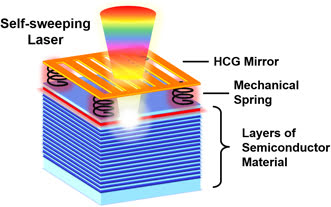A laser system that includes a mirror moved by the force of light could enable the miniaturization of 3D sensors for driverless cars and bioimaging.
The mirror, an ultrathin high-contrast grating, alters the frequency of the laser beam as it moves, making it suitable for lidar and optical coherence tomography (OCT).
"The advance could shrink components that now take up the space of a shoebox down to something compact and lightweight enough for smartphones or small [unmanned aerial vehicles]," said Connie Chang-Hasnain, a professor at the University of California, Berkeley, who led the project.

This "self-sweeping" laser couples an optical field with the mechanical motion of a high-contrast grating mirror. The force of the light causes the mirror to vibrate at high speed, allowing the laser to automatically change color as it scans. Courtesy of Weijian Yang.
Lidar works by shining a beam of light at a target and measuring the amount of time it takes to bounce back. Because the speed of light is constant, this system can be used to calculate distance. Self-driving vehicles and remote sensing technologies use lidar for navigation and the creation of 3D maps.
OCT applies the same principle of measurement to the scale of millimeters in medical imaging. The technology is used to create cross-sectional images of the retina and help with the early detection of retinal diseases, including age-related macular degeneration.
In both applications, as the laser moves along, it must continuously change its frequency so it can calculate the difference between the outgoing light and the incoming, reflected light. To change the frequency, at least one of the two mirrors in the laser cavity must move precisely.
"The mechanisms needed to control the mirrors are a part of what makes current lidar and OCT systems bulky, power-hungry, slow and complex," said Weijian Yang, a former UC Berkeley doctoral student who is now a researcher at Columbia University. "The faster the system must perform — such as in self-driving vehicles that must avoid collisions — the more power it needs."
The novelty of the design lies in its integration of the semiconductor laser with the grating mirror. Each laser can be as small as a few hundred square microns and can be readily powered by a AA battery. With an average force of just a few nanonewtons, the laser light exerts enough energy to cause the grating to vibrate.
In their experiments, the researchers found that this optomechanical interaction of the laser and the mirror can sweep across a wavelength range of more than 23 nm in the IR spectrum without the need for external controls.
"That wavelength range would be sufficient for a system that could resolve 50-μm surface profile features, even when the target is tens of meters away," said UC Berkeley doctoral student Adair Gerke.
Moreover, the period of the sweeping cycle can be as short as a few hundred nanoseconds, enabling several million sweeps per second. This speedy sweeping rate enables 3D image capture for real-time videos and visualization of depth change.
A U.S. Department of Defense National Security Science and Engineering Faculty Fellowship helped support the research, which was published in Scientific Reports (doi: 10.1038/srep13700).